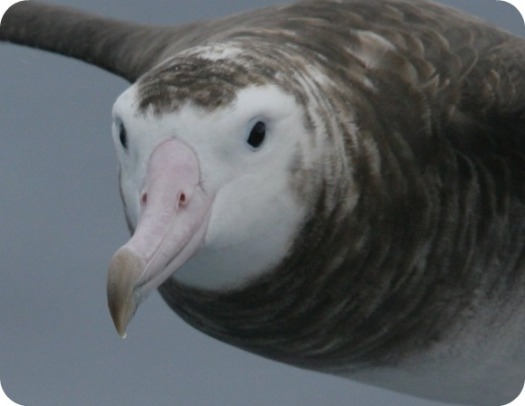John Cooper is an accomplished marine ornithologist who has worked all over the world studying seabirds. He is the founding editor of the Marine Ornithology journal, which he started in 1976 and his contributions to seabird ecology. He has received the Pacific Seabird Group Lifetime Achievement Award and the Gill Memorial Medal of BirdLife South Africa, which recognise his long-term dedication to protecting seabirds and their habitats.
John also played a part in forming the Agreement on the Conservation of Petrels and Albatross (ACAP). The organisation has 29 species under its protection and aims to protect petrel & albatross species and their habitats. Take a look at their website or follow them on Facebook!
He is currently on the Marion Islands (also known as the Prince Edwards Islands) but took some time from his busy schedule to talk to me about what it’s like to spend your life working with such incredible species.

Light-Mantled Sooty Albatross (Photo: ACAP)
How did you come to be an expert on seabird conservation and what drew you to study them?
During a post-graduate period in soil physics I was drawn to bird watching in tropical Africa. This turned into a research job working with African Penguins in the early 1970s and a 40-year seabird career ensued. I think most, if not all, field biologists become involved with the conservation of study species and their habitats.
What’s the greatest encounter you have had with an albatross or petrel?
When I sit down quietly and rest among the rising peaks surrounding Gonydale on South Atlantic’s Gough Island and watch as a Critically Endangered (and curious) Tristan Albatross walks towards within metres of me and starts a tentative courtship display – simply magical!

Tristan's Albatross in flight (Photo: Bird Holidays)
Then hike onto the Southern Giant Petrel study colony below Low Hump on the same island, where the incubating birds are so confiding they can be colour-banded on their nests without restraint, and off-duty birds will nibble at my boots and tug gently at my over-trousers – just in case they might be edible.
Such moments are hard to explain, but once experienced stay forever, to be brought to the front of the mind and savoured wherever one is.
Can you briefly explain the kind of research you have been doing on seabirds during your career?
My research has been primarily ecological in nature, and always aimed to the conservation of the species studied, and of their habitats. I have looked at such aspects as breeding success and diet. I now leave most of the actual research to the next generation of marine ornithologist, and concentrate more on conservation activities, both in the field (for example alien plant control on Gough Island) and from home via the internet, web sites and via social media (through communicating conservation messages to the wider world).

Gough Island (Photo: Wikipedia)
What is the biggest killer of albatrosses and petrels?
At sea it is the deleterious effects of trawl and long-line fisheries; on land it is human disturbance, pollution, habitat degradation and loss, and especially introduced predators such as cats and rats on their breeding islands
Why is it so important that we conserve albatross and petrels?
Ultimately, my philosophy is that the World in which we live and are part of will become a poorer place when any species becomes extinct before its time due to anthropogenic forces. For the general public, as well as for biologists, albatrosses especially among marine creatures are charismatic species that stir the heart as well as the mind, for example as witnessed by their regular appearance in poetry and art.
As top predators at the sea surface they can be seen as indicators of environmental health and harbingers of climate change. Put simply, their continued health is part of our own continued well-being
What’s the Agreement on the Conservation of Albatrosses and Petrels all about?
The main goal of ACAP is to help conserve the species (and their habitats) listed within the Agreement, currently 29 species of albatrosses and petrels, but expected to rise to 30 as a shearwater from the Mediterranean is likely to be listed later this month.
How was the agreement formed?
ACAP was originally an Australian initiative. Two negotiation meetings were held to develop its text, in Hobart, Australia, and in Cape Town, South Africa. I helped arrange the latter meeting. For an early history of ACAP and how it came about, take a look as this link.
How does the ACAP intend to change how many albatross and petrels are killed annually by (the answer to the above question)?
The Parties to the Agreement, via its Advisory Committee and Meeting Sessions set priorities. The Agreements’ three working groups represent the “engine” that generates actual activities. ACAP also funds to a limited amount research and management activities. Raising public awareness is also a crucial activity.
Perhaps most significantly ACAP is interacting with the five main tuna RFMOS (regional fishery management organizations) and with selected NGOs (such as BirdLife International) to reduce the mortality of albatrosses and petrels at sea by both long-line and trawl fisheries. Progress is slow but generally positive as the mind sets of fishers slowly change and mitigation measures are adopted.

White Chinned Petrel (Photo: Ben Phalan)
How does (the answer to the above question) and the ACAP apply to New Zealand’s Sub-Antarctic Islands?
New Zealand is a “founder” Party to ACAP. It also supports many of the ACAP-listed species, many endemic to its southern islands. New Zealand has led on developing methodologies for eradicating introduced mammals, especially rats, but also cats, pigs and goats, on seabird islands of ever-increasing size and ecological complexity. Such skills are being exported world-wide to help seabirds in all the World’s oceans.
